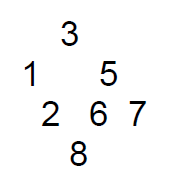对于大量的输入数据,链表的线性访问时间太慢,不宜使用——《数据结构与算法分析——C 语言描述》 p 65
对于大量的输入数据,适合用树结构,大部分操作都是 O( log N )。
二叉树
1. 实现
节点定义

template<typename T> struct Node { Node(T v) : val(v), left(nullptr), right(nullptr) {}; T val; struct Node *left; struct Node *right; };
构建树并添加节点
按照如图的树构建


Node<int> *root = new Node<int>(3); //根节点 root->left = new Node<int>(1); //根节点的左子树 root->left->right = new Node<int>(2); root->right = new Node<int>(5); //根节点的又子树 root->right->left = new Node<int>(6); root->right->left->left = new Node<int>(8); root->right->right = new Node<int>(7);
遍历
递归方式

template<typename T> void traversalRecursion(const struct Node<T>* const p) { if (p != nullptr) { cout << p->val; traversalRecursion(p->left); traversalRecursion(p->right); } else cout << "#"; }
非递归方式——用栈消除递归

template<typename T> void traversalStack(struct Node<T> *const root) { stack<struct Node<T>*> s; s.push(root); while (s.size()) { struct Node<T> *const p = s.top(); s.pop(); if (p == nullptr) { cout << "#"; continue; } cout << p->val; s.push(p->right); s.push(p->left); } }
表达式树
后缀表达式: a b + c d e + * *
从“后缀表达式”开始构造一颗表达式树,仅类定义

template<typename T> class ExpressionTree { public: struct Node<T>* initFormPostfix(const string &postfix) { istringstream iss(postfix); T c; while (iss >> c) { struct Node<T> *const p = new struct Node<T>(c); switch (characterType(c)) { case 0: sk.push(p); break; case 1: p->right = sk.top(); sk.pop(); p->left = sk.top(); sk.pop(); sk.push(p); break; } } return sk.top(); } private: int characterType(const T &c) const { if (c == "+" || c == "-" || c == "*" || c == "/") return 1; return 0; } stack<struct Node<T>*> sk; };
完整代码

#include <iostream> #include <string> #include <sstream> #include <stack> #include <memory> using namespace std; template<typename T> struct Node { Node(T v) : val(v), left(nullptr), right(nullptr) {}; T val; struct Node *left; struct Node *right; }; template<typename T> class ExpressionTree { public: struct Node<T>* initFormPostfix(const string &postfix) { istringstream iss(postfix); T c; while (iss >> c) { struct Node<T> *const p = new struct Node<T>(c); switch (characterType(c)) { case 0: sk.push(p); break; case 1: p->right = sk.top(); sk.pop(); p->left = sk.top(); sk.pop(); sk.push(p); break; } } return sk.top(); } private: int characterType(const T &c) const { if (c == "+" || c == "-" || c == "*" || c == "/") return 1; return 0; } stack<struct Node<T>*> sk; }; template<typename T> void traversalRecursion(const struct Node<T>* const p) { if (p != nullptr) { cout << p->val; traversalRecursion(p->left); traversalRecursion(p->right); } else cout << "#"; } int main() { string postfix = "a b + c d e + * *"; ExpressionTree<string> et; const struct Node<string> *root = et.initFormPostfix(postfix); traversalRecursion(root); return 0; }
二叉查找树
构建
构建如图所示的二叉查找树

构建 + 遍历 代码如下

#include <iostream> #include <initializer_list> #include <stack> using namespace std; template<typename T> struct Node { Node(T v) : val(v), left(nullptr), right(nullptr) {} T val; struct Node* left; struct Node* right; }; template<typename T> class BinarySearchTree { public: BinarySearchTree() { root = new struct Node<T>(0); } BinarySearchTree(const initializer_list<T> il) : BinarySearchTree() { initializer_list<T>::iterator it = il.begin(); root->val = *it++; while (it != il.end()) insert(*it++); } void insert(const T &val) { struct Node<T> **p = &root; while (*p != nullptr) { if (val == (*p)->val) return; if (val < (*p)->val) { p = &((*p)->left); continue; } if (val > (*p)->val) { p = &((*p)->right); continue; } } *p = new struct Node<T>(val); } void traversalStack() { stack<struct Node<T>*> s; s.push(root); while (s.size()) { struct Node<T> *const p = s.top(); s.pop(); if (p == nullptr) { cout << "#"; continue; } cout << p->val; s.push(p->right); s.push(p->left); } } private: struct Node<T> *root; }; int main(void) { BinarySearchTree<int> bst({ 8, 3, 10, 1, 6, 14, 4, 7, 13 }); bst.traversalStack(); return 0; }
查找 代码如下

struct Node<T>* find(const T &val) const { struct Node<T> *p = root; while (p != nullptr) { if (p->val == val) return p; if (val < p->val) p = p->left; if (val > p->val) p = p->right; } return nullptr; }
树的遍历
后序遍历
利用后序遍历求树的深度

unsigned getBinaryTreeHeigt(const struct Node *const p) { if (p == nullptr) return -1; else return 1 + max(getBinaryTreeHeigt(p->left), getBinaryTreeHeigt(p->right)); }
层序遍历
代码一,非递归实现

void levelOrderTraversal(struct Node *root) { queue<struct Node*> q; q.push(root); while (q.size()) { struct Node *p = q.front(); q.pop(); if (p == nullptr) continue; q.push(p->left); q.push(p->right); cout << p->val << " "; } }
代码二,递归实现

void levelVisit(queue<struct Node*> &que) { if (que.empty()) return; struct Node *p = que.front(); que.pop(); if (p == nullptr) return; cout << p->val << " "; que.push(p->left); que.push(p->right); levelVisit(que); }
利用队列可以完成二叉树的层序遍历(广度优先遍历);利用栈可以完成二叉树的深度优先遍历。
